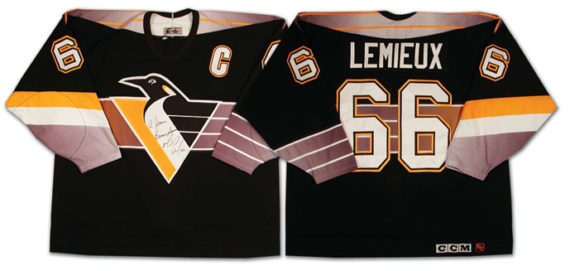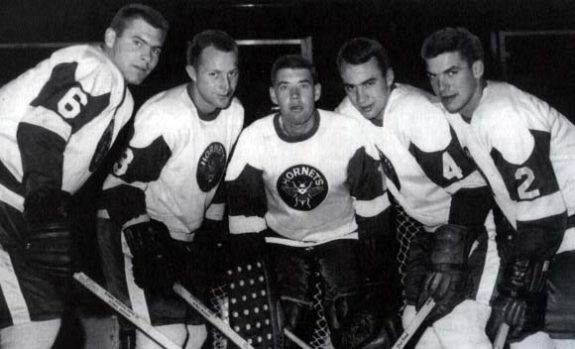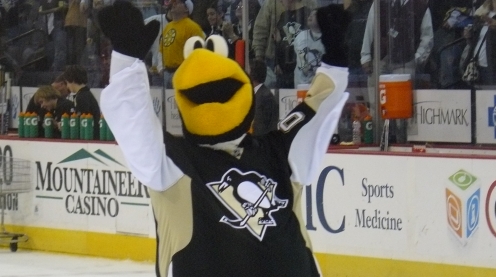Though it’s not the fiercest team name in the NHL, the Pittsburgh Penguins moniker has become associated with greatness over the franchise’s 52-year existence. It’s hard to believe that one simple write-in naming contest could have changed the entire branding of the team, eliminating things like slick black-and-gold uniforms, a great arena nickname, and even a few lovable mascots.

Naming Pittsburgh’s NHL Franchise
The Pittsburgh Pioneers? The Pittsburgh Crickets? The Pittsburgh Golden Triangles? In 1967, all of these were considered as potential names for the city’s new NHL franchise thanks to a naming contest conducted by local newspaper the Pittsburgh Post-Gazette and Mellon National Bank.
Over 26,000 entries were submitted and 716 people suggested the name Penguins. For those who picked the winning franchise name, a drawing was held between periods of a Pittsburgh Hornets game to present one lucky future fan with a color television set and a pair of season tickets.

However, team lore states that it was investor Jack McGregor’s wife, Carol, who first suggested to name the team the Penguins. According to Joe Starkey’s book Tales from the Pittsburgh Penguins Locker Room, it was because she liked the alliteration and wanted the team to have black and white uniforms.
Members of the new team’s investment and management staff were not thrilled with the choice. Publicity director Joe Gordon had to announce the name at a fancy dinner at the Pittsburgh Athletic Association, and those in attendance laughed. General manager Jack Riley purposely ordered ambiguous uniforms for the team’s first season – blue and white jerseys with the word Pittsburgh across the front – in hopes that the name would change before the first puck drop. He told the Pittsburgh Press:
“I thought the stockholders might change their minds about our name before the uniforms were ready,”
(from ‘Pittsburgh’s Hockey Name for the Birds,’ Pittsburgh Press – 9/7/67).
Riley’s distaste for the name was compounded by the heat he was taking from friends. During a league meeting in Montreal in June 1967, people would begin to waddle upon seeing him, trying to do their best impressions of a penguin.
Team coach George “Red” Sullivan tried to see the bright side of the new name, telling reporters:
“Look at it this way. Detroit has a team called the Red Wings and it’s a famous name in hockey. Well, what is a Red Wing, anyway? Is it a bird? Is it a flower? At least we have something that people recognize,”
(from ‘Pittsburgh Hockey Name for the Birds,’ Pittsburgh Press – 9/7/67).
Only team co-owner Pete Block seemed content with the naming choice. He told Jimmy Jordan of the Post-Gazette:
“It seemed natural. The penguin lives on ice; hockey players make their living on ice. And there is the nickname of ‘Big Igloo’ which has become a part of the Civic Arena,”
(from ‘Penguins Name for New Hockey Club,’ Pittsburgh Post-Gazette – 2/10/67).
For better or worse, the team had been named, and there was no going back. Team leaders began to shift their focus away from the naming debacle and toward recruiting fans. Is there a better place to start than with a lovable mascot?
Penguin Pete – The Team’s First Mascot
Following a less-than-stellar inaugural season when they finished fifth out of six in their division, the Penguins needed to find a way to bring in the crowds that went beyond scoring goals and winning games. In partnership with the Highland Park Zoo, now the Pittsburgh Zoo & PPG Aquarium, the team “adopted” an Ecuadorian-born Humboldt penguin named Pete to make appearances during games at the Civic Arena. Pete even received his own custom CCM blades and was learning how to skate as part of his act.
Pete made his debut at The Igloo on Feb. 21, 1968 during the second intermission of a game against the Philadelphia Flyers. He visited the arena six more times, making his final appearance during a game against the New York Rangers on Nov. 16, 1968. One week later, Pete died from pneumonia.
Some players felt that Pete died because he wasn’t properly cared for by team personnel and zoo handlers. Penguins defenseman Duane Rupp told Joe Starkey:
“He was a penguin, an animal, and they wanted to keep him warm. Well, he didn’t want to be warm. He wanted to be cold,”
(from ‘Tales from the Pittsburgh Penguins Locker Room,’ Sports Publishing – 2013).
Life After Penguin Pete
Following the death of Penguin Pete, the team wasted no time employing another Humboldt penguin as the mascot, who was cleverly named Re-Pete. This mascot made appearances through the 1971-72 season but did not receive as much notoriety as his predecessor.
Speaking of the original Pete, he was sent to a taxidermist following his death and was then displayed in the lobby of the Penguins’ team offices at the Civic Arena. Stuffed Pete made many visitors feel uncomfortable and management was asked to take him off display. It’s unclear what happened to Pete, whether he went home with a staff member, or if he was just thrown away.
Pittsburgh Welcomes Iceburgh
The Penguins franchise was without a mascot from 1972 to 1992. Head coach “Badger” Bob Johnson’s wife, Martha, suggested that the team adopt an official mascot. It seemed as good a time as any since they were flying high on back-to-back Stanley Cup championships and support was at an all-time high.

The new costumed mascot would not bear the same name as his ancestors, however. By 1992, Youngstown State University in Ohio held the rights to a penguin mascot named Pete. Instead, the franchise again instituted a naming contest through a local restaurant chain and Iceburgh the Penguin was born.
Since his institution, Iceburgh has made a name for himself and the Penguins not just in Pittsburgh, but across the globe. In addition to participating in community events like the Penguins’ annual visit to Children’s Hospital of Pittsburgh, Icebergh makes the yearly trip to the NHL All-Star Game and also participates in the Mascot Olympics in Orlando, Florida. He has performed in Russia and Japan, been featured in the opening of ESPN’s SportsCenter, and has a scene in the 1995 Jean Claude Van Damme film Sudden Death, produced by former Penguins owner Howard Baldwin.
Iceburgh is no longer the new mascot on the block, that title goes to the Flyers’ fluffy ball of fury, Gritty. However, he won’t be able to hold on to that distinction for long. With Seattle’s NHL team set to begin playing in the 2021-22 season, a name for the franchise, as well as a mascot will be chosen and announced soon. No matter what name is picked, the staff in Seattle is sure to make the best of it, just as those in Pittsburgh did over 50 years ago.